Your donation will support the student journalists of Marjory Stoneman Douglas High School. Your contribution will allow us to purchase equipment and cover our annual website hosting costs.
March For Our Lives reemerges four years later
June 21, 2022
“This is not a moment. This is a movement,” March For Our Lives tweeted.
Four years after the first March For Our Lives protest, protesters were back in the streets of D.C. and other cities all across the country to advocate for gun violence prevention measures to be passed in Congress and send the message that Americans cannot “just accept mass shootings.”
MFOL was founded in 2018 by survivors of the shooting at Marjory Stoneman Douglas High School to help prevent gun violence from happening again, leading to the common cry of, “Not one more” and “Enough is enough.”
Their first protest was held on March 24, 2018. Four years later, they held another one in wake of the shootings in Buffalo, New York that targeted the Black community and killed 10, and the shooting in Uvalde, Texas that killed 21 students and teachers.
“Together. Together, we must get this done,” speaker Gail Schwartz said in her speech.
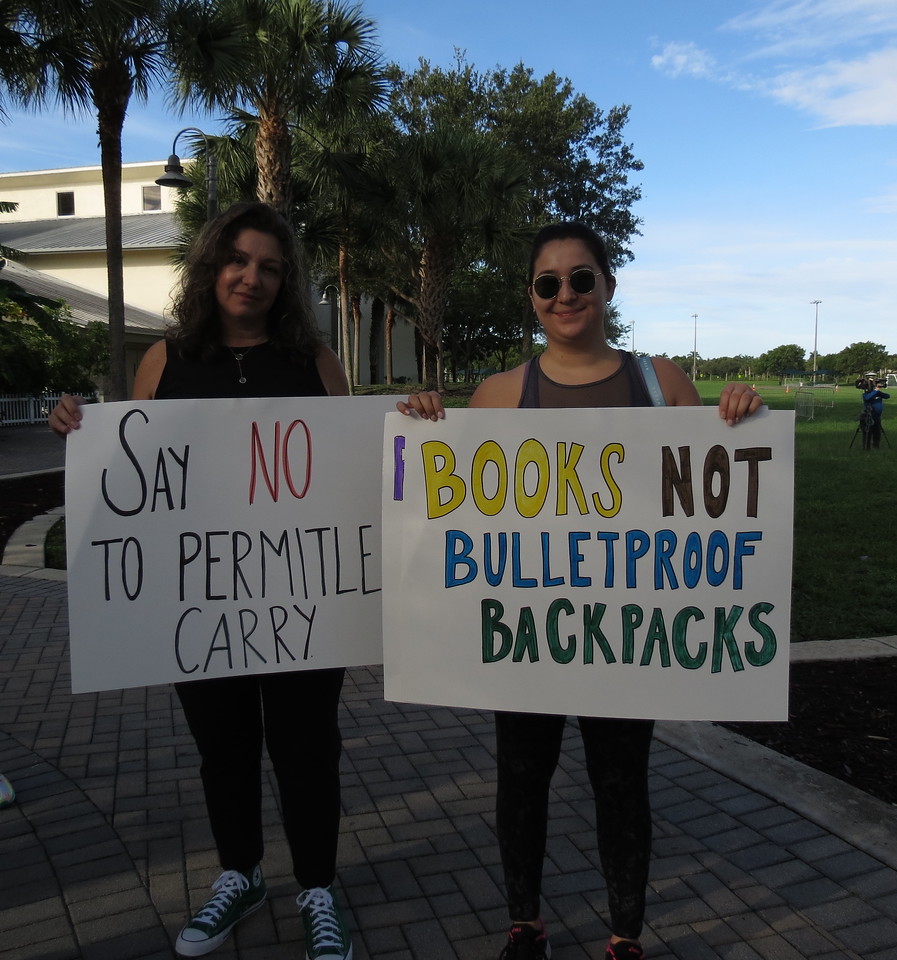
Candidate for U.S. Congress Hava Holzhauer and a fellow protestor hold up signs advocating for gun control. Their signs read “Say NO to permitless carry” and “Books Not Bulletproof Backpacks.”
Thousands participate in nationwide March for Our Lives rallies to fight for gun reform
Sunlight lights up the shadows of activists gathered around a stage. Mothers, fathers and children united together to fight for the same cause: gun reform. Affected by various personal experiences, these individuals hold up decorated signs and shout out empowering phrases.
On Saturday, June 11, rallies were scheduled in more than 400 cities nationwide. Organized by March for Our Lives, a student-led movement centered around gun violence prevention, the event drew in thousands of participants. The demonstration emerged barely three weeks after the Uvalde shooting in Texas that took the lives of 19 elementary school students and two teachers.
“I can’t believe that Uvalde, Texas has now occurred. It’s unbelievable that we’re still in the same situation that we were all those years ago. Columbine 20 years ago. Something’s got to change,” Parkland resident and mother Marlene Pagal said. “I think there are a lot of thoughts and prayers, but not a lot of action.”
One of the many rallies took place in Parkland, Florida, the site of a mass shooting at Marjory Stoneman Douglas High School four years ago. Approximately 3,000 individuals marched together to address gun violence and reform.
“Although I’ve been somewhat active, I actually feel that people like me haven’t done enough to lead things to change, particularly with respect to the shootings in schools,” Parkland resident Jim Fenoglio said. “I think that the adults in the room have let society down by continuing to put our kids at risk, so that’s why I’m here.”
In light of the recent increase in shootings, the public continues to adamantly push lawmakers in Congress to make decisions in regard to gun control. At the rallies themselves, several guest speakers talked about their personal experiences with gun violence and how it affected the rest of their lives.
“I think that the fact that we’re having a lot of different voices who have experienced gun violence in a way that maybe our community hasn’t, whether it be inner-city violence or domestic violence, I think that will make people realize just how pervasive it is. Hopefully, the national media coverage will get people to listen to us one more time,” President of March for Our Lives Parkland Zoe Weissman said.
Speakers included Debra Hixon, who lost her husband Chris Hixon in the Parkland shooting, the Circle of Brotherhood, who spoke about the normalization of gun violence in their communities, and Sari Kaufman, who survived the Parkland shooting and helped organize the recent March for Our Lives event in Parkland.
Other dominant topics included voting power and speaking out. A common phrase shouted throughout the event was “Vote them out,” referring to the senators and representatives who have done little to nothing to resolve the gun violence issue America faces.
“How do you do nothing? How do you not respond to a disaster when kids and babies are slaughtered in school? How was the response? Nothing,” Broward County Commissioner Jared Moskowitz said. “If [Texas] passed the Florida law, [what happened in Uvalde] wouldn’t be happening in Texas. They made it too easy to get guns in Texas.”
While Florida has made improvements, such as raising the age to purchase a gun to 21 years old and implementing red flag laws, few states have followed in their footsteps.
“The most important thing about this is that when everyone comes together, it sends a really important message to our U.S. senators that this is an issue. We’re going to keep fighting until you actually take action to make us safe. That’s what this is about,” Congressman Ted Deutch said.
In the months leading up to the primary and general elections in the fall, more individuals will likely register to vote. The objective of March for Our Lives is in the hands of the people, especially an emerging generation of young activists. In 2018, voter turnout among 18-to-29-year-olds jumped 16% from 2014, according to the United States Census Bureau.
“I want to make sure that this movement is not just a moment, that it is showing strength all across our state, all across our country. That we are demanding action, that we are demanding that people in Tallahassee and that people in Washington, D.C. realize that people are no longer with them, that we need to be protecting our kids,” Florida Commissioner of Agriculture and Florida gubernatorial candidate Nikki Fried said.

MSD shooting survivor Sari Kaufman spoke at the March, urging politicians to make change and for attendees to “keep fighting.”
March for Our Lives speakers shame elected officials for ‘inaction’ regarding gun violence prevention
“Today, survivors and activists stand before you as we demand change,” March For Our Lives Parkland President Zoe Weissman said.
MFOL, a youth-led organization dedicated to ending gun violence, held its second nationwide protest on Saturday, June 11, after the shooting at Tops Friendly Markets supermarket in Buffalo, New York that killed 10 people and the shooting at Robb Elementary School in Uvalde, Texas that killed 21 people.
The main protest took place in Washington, D.C., with over 400 sibling events taking place all over the United States, including one in Parkland, Florida.
MFOL was founded by Marjory Stoneman Douglas High School students after the shooting at MSD on Feb. 14, 2018, which left 17 students and staff dead. The organization led one of the largest youth protests since the Vietnam War on March 24, 2018.
The largest protest of MFOL in 2018 took place again in Washington D.C., with over 830 sibling events occurring around the globe on the same date. Speakers at those events included Jaclyn Corin, X González, Edna Chavez, David Hogg, Naomi Wadler, Cameron Kasky and Yolanda King.
In Parkland, the event kicked off with the National Anthem, sung by Alexa Aronson, and the original song “Quiet,” written and performed by MILCK. MILCK also performed a duet with ShineMSD of the song “A Little Peace/The Flower.”
Sixteen-year-old Weissman is president of the Parkland chapter at March For Our Lives and kicked off the event by declaring that Americans still have to march, four years after the shooting at MSD.
“People say most movements take a long time until change is made, but ten years since the Sandy Hook shooting and four years since the Parkland shooting seems like a pretty long damn time to me,” Sari Kaufman, a speaker at the event on June 11 in Parkland and gun violence prevention activist, said in her speech.
Kaufman, a sophomore at Yale University and founder and president of MyVote Project, was a sophomore at MSD when the shooting happened. The shooting inspired her to become an engaged citizen, joining MFOL on the Change committee and founding MyVote Project.
“We have done our jobs. We had record youth voter turnout in 2018,” Kaufman said. “We have passed red flag laws in more than 20 states, even here, in the ‘Gunshine’ state,, and we helped change the culture around gun violence prevention. Now, more than 80% of Americans support background checks and red flag laws.”
Kaufman’s statistics are true. A recent survey from Morning Consult and Politico showed 88% of Americans support background checks on all gun sales, while a Pew Research Center survey found overall support at 81%. Pew’s survey was among the lowest, with Quinnipiac and ABC/Washington Post in 2021 both finding 89% and Gallup finding 92%.
According to a survey by APM Research Lab, 77% of Americans think a family member should be able to petition a court to temporarily keep guns from people who may be a threat to themselves or others, also called a “red flag” law, while 70% think police should be able to.
These statistics, Kaufman argues, prove that gun control is not a “Democrat vs. Republican” issue, as she argued in her speech. She believes, instead, that it is an “American” issue and a public health and safety issue.
Debbi Hixon, Broward County Public Schools school board member and wife to Chris Hixon, who was murdered in the MSD shooting, agreed with this statement, calling it a “human” issue in her speech.
“What people don’t realize is after the cameras leave, after the news cycle changes, we are still here, still grieving, still wondering why,” Hixon said. “Well, I know why. Because it’s all too easy for a 19-year-old murderer to walk into a store, purchase a weapon of war and steal lives.”
Hixon’s son, Corey Hixon, held up a photo of Chris Hixon on stage as she spoke. Hixon described how Chris, a veteran who served in the Navy for 27 years, died while trying to disarm the shooter, saying Chris and all Americans “deserve better.”
“He survived a war, but he did not survive a day at school,” Hixon said.
Hixon’s point echoes the many points made at the Parkland MFOL and others around the country, arguing that Americans should be free to do daily, mundane activities like attending a synagogue or a concert without the fear of being shot. One of these people was Florida state representative Anna Eskamani, who attended the MFOL in Orlando, and she listed several shootings in the United States within the last few decades.
“We honor those no longer with us through action and stand united in finding power in pain, as we remember the victims lost to gun violence in this country一those in the headline and those you will never hear about. Columbine, Virginia Tech, a movie theater in Aurora, Colorado, a Sikh temple in Wisconsin,” Eskamani said. “Sandy Hook Elementary School in Connecticut, a Naval facility in Washington DC, an African American church in South Carolina, Planned Parenthood Health Center in Colorado, a holiday party in San Bernardino, California. Latin night at Pulse Nightclub, a country music concert in Las Vegas, Nevada, a high school in Parkland, a Taiwanese church in California, spas in Atlanta, Georgia, a yoga studio in Tallahassee, Florida, a Walmart in El Paso, Texas, an African American grocery store in Buffalo, New York and Robb Elementary School in Uvalde, Texas. Not one more.”
Several speakers at the Parkland MFOL, as well as Eskamani, spoke about how gun violence is not just school shootings, or as speaker Romania Dukes added, and against Black and brown people.
Regarding Black and brown people, speaker Albert Campbell from the Circle of Brotherhood organization in Miami contended that the violence his community faces unites his community and the Parkland community. He asked attendees to put one finger in the air and repeated, “We are one.”
MSD yearbook adviser Sarah Lerner, who spoke at the event, emphasized that school shootings are not the only type of gun violence to focus on; people should also focus on gun violence against Black and brown people, LGBTQ+ people, Asian people and Jewish people.
Speaker Megan Vaz, a domestic violence survivor, added women into that discussion, talking about her personal experience as a woman abused by her father and threatened by his guns. She backed this up with evidence that supports that one large red flag in mass shooters is their misogynistic behaviors.
Eskamani’s statement of “Not one more,” repeated at the MFOL in Parkland during the march itself, is one of the reasons MFOL was started, as they wanted the gun violence epidemic to end with them. MFOL maintains that not one more person should die from gun violence, as over 100 Americans die because of it every day.
“A shooting should not have happened at my school, but it also should’ve stopped at my school,” Lerner said in her speech at the event.
Lerner chalks up the fact that it did not stop at MSD to failures in government by politicians and leaders, adding that if they do not do their job, they should be voted out.
“We the people elect our lawmakers and leaders; they work for us. They do not work for the National Rifle Association and they do not work for the gun lobby,” Lerner said. “They need to do their jobs to keep us safe or they need to be voted out.”
Several times during her speech, chants broke out in the crowd, declaring, “Vote them out.” Among those slammed at the event and threatened to be voted out were Florida Senator Marco Rubio and Florida Governor Ron DeSantis.
“It’s not good enough to simply hope and pray our children aren’t shot; we actually have to vote for someone who cares about this issue and is actually committed to doing something about it,” speaker Gail Schwartz said. “If your candidate isn’t loudly declaring the desire and the urgency to help prevent mass shootings in our communities by halting the proliferation of killing machines like AR-15s and AK-47s, then they are not deserving of your vote.”
Schwartz lost her nephew, Alex Schachter, in the shooting at MSD. The shooter used one of the aforementioned weapons, an AR-15. AR-15s were also used in the shootings in Uvalde, Buffalo, Boulder, Orlando, Las Vegas, Aurora, Sandy Hook, Nashville, San Bernardino, Midland-Odessa, Poway, Sutherland Springs and Pittsburgh.
“No one stopped this killer [in Uvalde, Texas]. Certainly not the kids, not the educators, not even law enforcement that showed up on the scene and waited outside. No one,” Schwartz said. “We must never forget what happened to 49 friends up in Orlando that were executed at a nightclub. No one came to their rescue, either. Our lives shouldn’t depend on someone coming to the rescue because history has shown, time and again, no one is coming to the rescue.”
Schwartz told the crowd that the only people coming to the rescue is “us” with their votes. She attempted to motivate and inspire the crowd to vote in November, as the midterm elections are this year, and told those not already registered to vote to register at the stands set up surrounding the march.
“In my 2018 speech, I also noted that this fight would be a marathon and that the students of Stoneman Douglas and the students across this country would be your coaches and your motivators to keep fighting,” Kaufman said. “So, four years later, we are still telling you to keep running, to keep fighting because I do believe that this time will be different.”

At the March for Our Lives event on Saturday, hundreds of protesters held signs illustrating their feelings on gun violence and reform in our country.
Marchers hold signs to convey their frustration, fear and views on the current status of gun control in the U.S.
Protestors have relied on using signs to display their thoughts to the public on various topics since rallies were first broadcasted on televisions or photographed in the 1960s. Rallies for voting rights, civil rights, women’s rights, political campaigns and more have now transformed into a sea of signs and while it is an effective method, the deep meaning of some of these signs can get drowned out by the loud, crowded protest.
Four years after the first March for Our Lives dedicated to the victims of the shooting at Marjory Stoneman Douglas High School and gun violence victims across the country, the community gathered again to protest the lack of political change since that event. Out of the crowd of about 3,000 marchers, there were hundreds of signs. Below is a breakdown of a select few that illustrate important topics surrounding gun safety and ones that have personal meanings to the protestor.
Toxic masculinity and gun violence
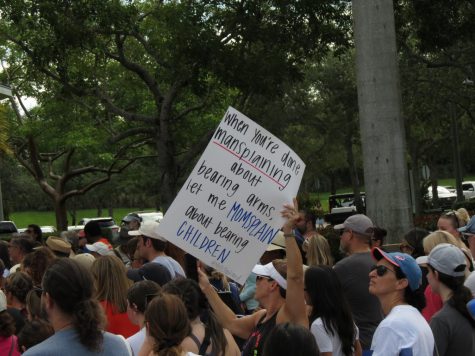
The term ‘mansplain’ is a popular one with today’s youth, defined as “when a man explains something to a woman in a patronizing tone as if the woman is too emotional and illogical to understand,” according to the Urban Dictionary. The desensitization of gun violence in America and the way in which pro-gun male representatives discuss it can make those, like the protestor shown, feel it removes the bottom line that gun violence is killing children.
Even deeper, this term correlates even more to gun violence in its relation to toxic masculinity. Toxic masculinity is the social science term that describes the harmful traits society associates with what makes a man ‘masculine’ that can lead men to be sexually aggressive to seem dominant or become violent after unreleased emotions; traits like showing no emotion, being the alpha, strong, etc.
This violence can turn to gun violence; in a nutshell men, especially those in their late teens/early twenties, buy large guns to seem more masculine and with their repressed emotions, they can act out. According to a study by the Violence Project, men are responsible for 98% of mass shootings.
Men are also responsible for 80% to 90% of all homicides in the country; which brings a further link to domestic gun violence. According to the Educational Fund To Stop Gun Violence’s report on Domestic Violence and Firearms nearly half of all women murdered in the United States are killed by a current or former intimate partner, and more than half of these intimate partner homicides are by firearm.
“Pro-life” v.s. gun reform

According to the Center for Disease Control and Prevention, the number one cause of mortality in children ages 1-19 is firearm related injuries after a 13.5% increase in recent years that now surpasses motor vehicle crashes. Even with this increase, gun reform laws and regulations have not increased in a rate anywhere near that.
“Columbine happened when I was in eighth grade, and since then we have had more than three hundred school shootings and it’s just like at what point is it going to be enough to make people stop and understand that our kids deserve better? That they deserve a childhood and they don’t deserve lockdowns all the time and [to] be afraid of what’s going to happen,” marcher and teacher at Cooper City High School Fallan Patterson said. “Parents don’t deserve to be scared to send their kids to school. My son is going into eighth grade now一it’s a weird bookend in my life.”
The pushback on gun reform has come from the Republican majority in the Senate that stops any meaningful gun laws to be passed after they go through Congress. However, another major platform for Republicans is their “pro-life” stance regarding abortions.
After the leaked draft of the Supreme Court’s decision to overturn Roe v. Wade, the Supreme Court ruling that the federal government protects a woman’s right in America to have an abortion, many Republican senators and congressmen have continued to voice their “pro-life” beliefs that abortions are ‘wrong.’ The main claim against abortions is that it is killing the conceived baby in the uterus of the person housing the baby, giving it no chance at life.
And while the debate surrounding whether the baby is “alive” or conscious doesn’t have a clear true or false answer, many “pro-choice,” those who are for womens’ right to choose to have an abortion or not, and gun reform supporters feel that this stance is hypocritical. “Protect the already born,” refers to the common argument by gun control advocates that feel as if Republicans opposing abortions because they care about protecting the lives of unborn babies is hypocritical. They argue that while Republicans attempt to protect the lives of unborn children, they “neglect” to pass laws gun control supporters believe will protect their already-alive children that attend school and are threatened by guns. Believers in this argument often feel that the arguments lies in that “If they are so ‘pro-life’ for children, then why aren’t they protecting the ones who are already alive and suffering?”
“I can’t stand that [the government] won’t make laws to protect our children, they keep getting money from the NRA and gun lobbyists. They need to think more about the children than the money in their pockets,” marcher Richard Cassey said.
“Does anyone really need an assault rifle?”
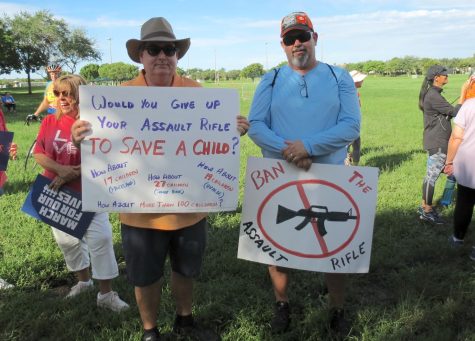
Self-defense is usually one of the main arguments as to why “banning guns is bad.” And while it’s not a totally false claim, Harvard’s School of Public Health Injury Control Research Center finds “the claim of many millions of annual self-defense gun uses by American citizens is invalid.” Most often, guns are used as an intimidation tactic rather than to actually protect oneself.
The other main argument is that it’s an American right. But if guns are the number one killer of children in our nation and there have been over 250 mass shootings in 2022 alone, regulation of that right (to be clear, not total ban of all guns), to Americans in support of gun control, does not seem like a drastic ask.
“I became involved [in the fight for gun safety] sometime after Sandy Hook, because that personally affected me. I have grandchildren, and I would be devastated if that happened to one of them,” marcher Debra Davis said. “It is a tragedy, it is an unthinkable and preventable一that’s the big word here, these are preventable tragedies; we don’t have to have these things happen.”
When specifically talking about the regulations asked, banning semi-automatic assault rifles is a main goal of gun violence prevention advocates. A semi-automatic assault rifle is used to kill, it does not simply hurt the person being shot at; it is designed to kill. The most high profile mass shootings in the U.S., like in Las Vegas, Parkland, Uvalde, Sandy Hook, Orlando, etc. were all committed by semi-automatic assault rifles. And while the majority of shootings have been committed using handguns, the ones that kill the most people use assault rifles.
Other signs had personal meanings to those directly affected by gun violence.
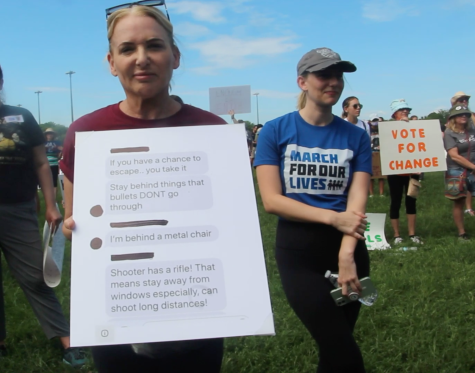
Sara Lowell is a mother of two; her daughter was a senior and her son was a freshman attending MSD when the shooting occurred. Her sign illustrates the text messages sent between her, her son and her daughter while he was in the 1200 building during the shooting hiding behind a metal chair and both of them fearing he would not make it out safely.
“We want to stay as active as we can spreading the message … and if we didn’t we would just become complacent and nothing would happen; this is how change happens,” Lowell said. “We are the only country in the world where it seems that the 50 senators are not listening to the entire country. An 18 year old can’t buy a beer but they can buy an assault rifle, so much in our country needs to change, we are all fed up and pissed.”
She attended the first March for Our Lives after the shooting and returned because of her anger towards the lack of change since the event and since the traumatic event her family and community had to endure.
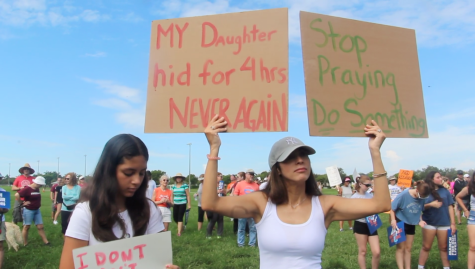
Iris Espinoza is a mother of three, one of her daughters attending Westglades when the MSD shooting occurred. This is her first march, she is tired of fearing how safe her children are while attending school.
“I am sickened by what’s happening in our world一in our country一I have three kids that go to school every single day and everyday I send them to school I pray in my car that I see them again and that’s ridiculous,” Espinoza said.
Her sign reads “My daughter hid for four hours NEVER AGAIN,” as she was unable to message her daughter that day because she didn’t have her phone and her daughter had to hide in a closet with her English teacher. She is upset that anyone in our country of any age or mental state has the ability to buy a weapon of war, referring to the semi-automatic rifles that those like the Parkland shooter and others use in these school shootings like the one her family had to live through.
